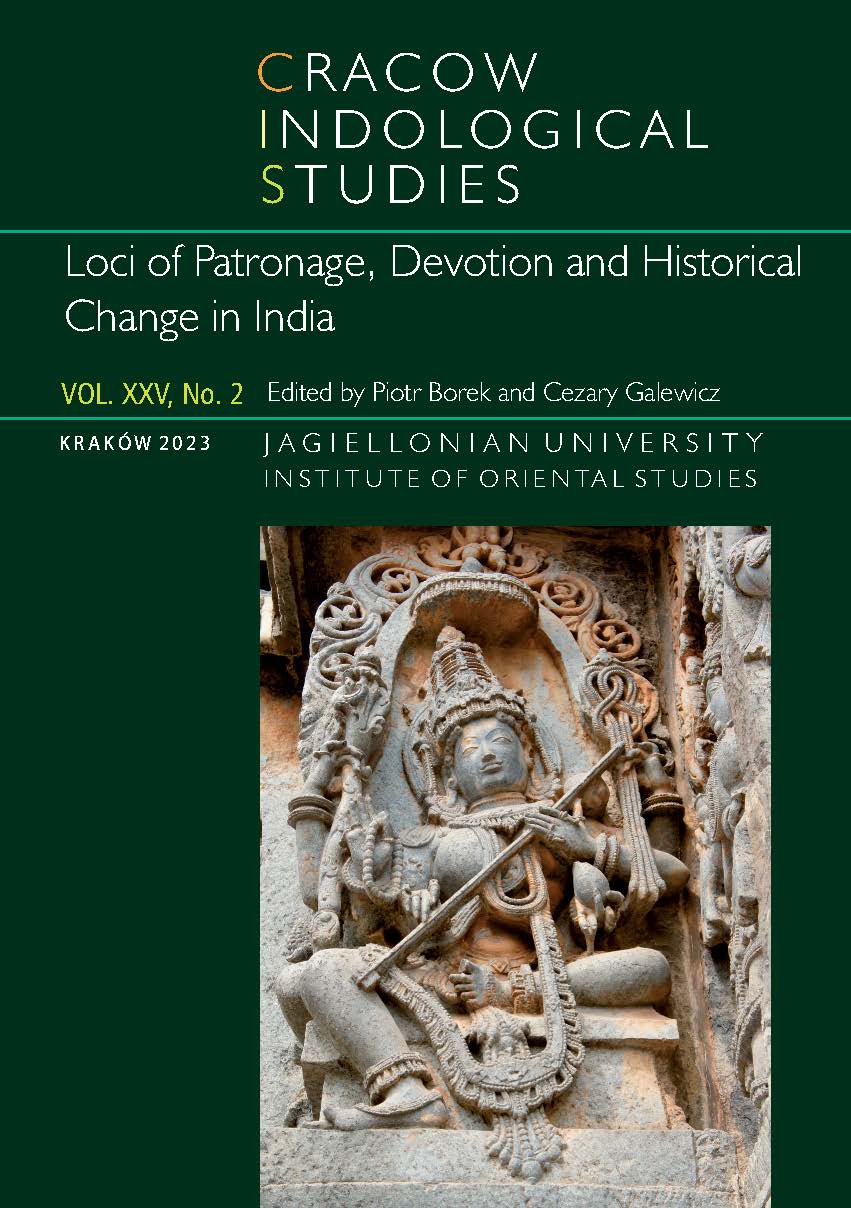Poetry and Legitimacy at the Mughal Court
Selected Tasks of a Poet according to the Text of Čahār čaman by Chandar Bhan Brahman
DOI:
https://doi.org/10.12797/CIS.25.2023.02.06Keywords:
Chandar Bhan Brahman, Mughal, patronage, Persianate, LegitimacyAbstract
The present paper proposes to take a new look at the imperial Mughal court’s pattern of patronage of arts and letters as a vital and indispensable component of the imperial state machinery on the one hand and an instrument of historical change on the other. It focuses on, and draws from, Čahār čaman, a mid-17th-c. work by Chandar Bhan Brahman, one of the prominent figures among poets, writers, scribes and secretaries in Mughal service; a person involved in the never-ending, and aesthetically intricate, ceremonial exchange of goods, honors, acts of refined praise and proofs of recognition that not only made up the rich and variegated courtly milieu of the period but also gave form and actively shaped the ethos of the Mughal state’s pattern of self-representation—all in the service of legitimating the imperial power and its expanding claim over increasingly vaster stretches of the Indian subcontinent and its regional rulers and their riches. The same was done in the garb of sophisticated aesthetics of imperial power that demanded rulers, princes, prominent chiefs and officers, executive clerks, accountants and administrative professionals to communicate and ever prove anew their status and position in the language and manners recognized as aesthetically pleasing and in the form requiring literary, if not poetical, skills and competence based on knowledge of recognized expressive forms and appropriate genres as well as individual talent and personal ambition.
References
Alam, M. and S. Subrahmanyam. 2004. The Making of a Munshi. Comparative Studies of South Asia, Africa and the Middle East, 24(2): 61–72. https://doi.org/10.1215/1089201X-24-2-61. DOI: https://doi.org/10.1215/1089201X-24-2-61
Bayly, C. A. 1996. Empire and Information. Cambridge: Cambridge University Press.
Begley, W. E. 1984. Afżal Khan. In: Encyclopaedia Iranica, 1(6): 601–602. http://www.iranicaonline.org/articles/afzal-khan-title-of-mollasokrallah-sirazi-mughal-court-official-ca (an updated version accessed on 1.08.2022).
Esposito, J. L. 2003. The Oxford Dictionary of Islam. Oxford–New York: Oxford University Press.
Floor, W. 2017. Ḵel’at. In: Encyclopaedia Iranica, 16(3): 226–229. http://www.iranicaonline.org/articles/kelat-gifts (accessed on 2.08.2022).
Hansen, W. 1986. The Peacock Throne: The Drama of Mogul India. Delhi: Motilal Banarsidass.
Harit, J. 2019. The Politics of Ceremonial in Shah Jahan’s Court. In: E. Koch and A. Anooshahr (eds). The Mughal Empire from Jahangir to Shah Jahan: Art, Architecture, Politics, Law and Literature. Mumbai: Marg Publications: 108–131.
Jaffery, M. Y. (ed.). 2007. Čahār Čaman. New Delhi: Xāne-ye Farhang-e Ǧomhuri-ye Eslāmi-ye Irān Press.
Kinra, R. 2010. Master and Munshī: A Brahman Secretary’s Guide to Mughal Governance. The Indian Economic & Social History Review, 47(4): 527–561. https://doi.org/10.1177/001946461004700405. DOI: https://doi.org/10.1177/001946461004700405
–––. 2015. Writing Self, Writing Empire: Chandar Bhan Brahman and the Cultural World of the Indo-Persian State Secretary. Oakland: University of California Press.
–––. 2020. Revisiting the History and Historiography of Mughal Pluralism. ReOrient, 5(2): 137–182. https://doi.org/10.13169/reorient.5.2.0137. DOI: https://doi.org/10.13169/reorient.5.2.0137
Kulshreshtha, J. N. 1976. A Critical Study of Chandra Bhan Brahman and His Works. Aligarh: Aligarh Muslim University Press.
Lefèvre, C. 2014. The Court of ‘Abd-ur-Raḥīm Khān-i Khānān as a Bridge Between Iranian and Indian Cultural Traditions. In: A. Busch and T. de Bruijn (eds). Culture and Circulation. Literatures in Motion in Early Modern India. Leiden: Brill: 75–106, https://doi.org/10.1163/9789004264489_005. DOI: https://doi.org/10.1163/9789004264489_005
–––. 2019. Mughal Early Modernity and Royal ādāb: Shaykh ʿAbdal-Ḥaqq Muḥaddith Dihlawī’s Sufi Voice of Reform. In: C. Mayeur-Jaouen (ed.). Adab and Modernity. A “Civilising Process”?
Leiden: Brill: 63–92. https://doi.org/10.1163/9789004415997_004. DOI: https://doi.org/10.1163/9789004415997_004
Mishra, V. B. 1973. Religious Beliefs and Practices of North India during the Early Mediaeval Period. In: Handbook of Oriental Studies. Section 2: South Asia, Vol. 3, Leiden–Köln: Brill. https://doi.org/10.1163/9789004493001. DOI: https://doi.org/10.1163/9789004493001
Mo’in, M. 2002. Farhang-e Fārsi, Vol. 1. Tehran: Entešārāt-e Adena.
Qāsemi, S.-H. 1990. Čandra Bhān. In: Encyclopaedia Iranica, 4(7): 755–756. https://www.iranicaonline.org/articles/candra-bhan-or-candarbhanbarahman-indian-poet-and-writer-in-persian-b (accessed on 30.07.2022).
Wink, A. 2008. Akbar. London: Oneworld Academic.
Yūsofī, G.-H. 2000. Calligraphy. In: Encyclopaedia Iranica, 4(7): 704–718. https://iranicaonline.org/articles/calligraphy-2 (accessed on 3.08.2022).
Downloads
Published
Issue
Section
License

This work is licensed under a Creative Commons Attribution-NonCommercial-NoDerivatives 4.0 International License.
How to Cite
Funding data
-
Narodowe Centrum Nauki
Grant numbers 2018/31/B/HS2/02328: UMO-2018/31/B/ HS2/02328






